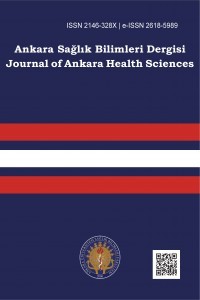Ebeveynlerin Disiplin Uygulamaları GDB şüphesi olan çocukların sözcük dağarcığı ile ilişkili midir?
Gelişimsel dil bozuklukları, ebeveynlik davranışı, kelime hazine gelişimi
Are parental disciplinary practices associated with the vocabulary of children with suspected DLD?
___
- Arkan, B., Bektaş, M., Öztürk, C., Özyazıcıoğlu, N., & Vural, P. (2019). A reliability and validity study of the Turkish version of the Parenting Scale. The Journal of Pediatric Research, 6(1), 56-64. https://doi.org/10.4274/jpr.galenos.2018.23855
- Arnold, D.S., O'leary, S.G., Wolff, L.S., & Acker, M.M. (1993). The Parenting Scale: A measure of dysfunctional parenting in discipline situations. Psychological Assessment, 5, 137-144. https://doi.org/10.1037/1040-3590.5.2.137
- American Speech-Language-Hearing Association. (2005). Guidelines for manual pure-tone threshold audiometry [Guidelines]. Available from www.asha.org/policy.
- Berko-Gleason, Jean (ed.), The development of language, 6th edn. Boston, MA: Pearson, 2005.
- Bishop, D. V. M., Snowling, M. J., Thompson, P. A., Greenhalgh, T., & and the CATALISE-2 consortium. (2017). Phase 2 of CATALISE: a multinational and multidisciplinary Delphi consensus study of problems with language development: Terminology. Journal of Child Psychology and Psychiatry, and Allied Disciplines, 58(10), 1068–1080. https://doi.org/10.1111/jcpp.12721
- Cartmill, E. A., Armstrong, B. F., 3rd, Gleitman, L. R., Goldin-Meadow, S., Medina, T. N., & Trueswell, J. C. (2013). Quality of early parent input predicts child vocabulary 3 years later. Proceedings of the National Academy of Sciences of the United States of America, 110(28), 11278–11283. https://doi.org/10.1073/pnas.1309518110
- Ford, J. A., & Milosky, L. M. (2003). Inferring emotional reactions in social situations: differences in children with language impairment. Journal of Speech, Language, and Hearing Research: JSLHR, 46(1), 21–30. https://doi.org/10.1044/1092-4388(2003/002)
- Hughes S. (2014). Bullying: what speech-language pathologists should know. Language, Speech, and Hearing Services in Schools, 45(1), 3–13. https://doi.org/10.1044/2013_LSHSS-13-0013
- Hwang, J. K., Mancilla-Martinez, J., Flores, I., & McClain, J. B. (2022). The relationship among home language use, parental beliefs, and Spanish-speaking children's vocabulary. International Journal of Bilingual Education and Bilingualism, 25(4), 1175–1193. https://doi.org/10.1080/13670050.2020.1747389
- Lee, J. (2011). Size matters: Early vocabulary as a predictor of language and literacy competence. Applied Psycholinguistics, 32(1), 69–92. https://doi.org/10.1017/S0142716410000299
- Limia, V., Özçalişkan, Ş., & Hoff, E. (2019). Do parents provide a helping hand to vocabulary development in bilingual children?. Journal of Child Language, 46(3), 501–521. https://doi.org/10.1017/S0305000918000594
- Macleod, A. A., Fabiano-Smith, L., Boegner-Pagé, S., & Fontolliet, S. (2013). Simultaneous bilingual language acquisition: The role of parental input on receptive vocabulary development. Child Language Teaching and Therapy, 29(1), 131–142. https://doi.org/10.1177/0265659012466862
- Marchman, V. A., & Fernald, A. (2008). Speed of word recognition and vocabulary knowledge in infancy predict cognitive and language outcomes in later childhood. Developmental Science, 11(3), F9–F16. https://doi.org/10.1111/j.1467-7687.2008.00671.x
- Marton, K., Abramoff, B., & Rosenzweig, S. (2005). Social cognition and language in children with specific language impairment (SLI). Journal of Communication Disorders, 38(2), 143–162. https://doi.org/10.1016/j.jcomdis.2004.06.003
- Rowe, M. L. (2022). Environmental influences on early language and literacy development: Social policy and educational implications. Advances in Child Development and Behavior, 63, 103–127. https://doi.org/10.1016/bs.acdb.2022.04.001
- Schober, P., Boer, C., & Schwarte, L. A. (2018). Correlation Coefficients: Appropriate Use and Interpretation. Anesthesia and Analgesia, 126(5), 1763–1768. https://doi.org/10.1213/ANE.0000000000002864
- St Clair, M. C., Forrest, C. L., Yew, S. G. K., & Gibson, J. L. (2019). Early Risk Factors and Emotional Difficulties in Children at Risk of Developmental Language Disorder: A Population Cohort Study. Journal of Speech, Language, and Hearing Research: JSLHR, 62(8), 2750–2771. https://doi.org/10.1044/2018_JSLHR-L-18-0061
- Topbaş, S., Gökçümen-Koca, G., & Rescorla, A. (2016). Early Expressive Language Development of Toddlers: Adapting the LDS to Turkish (DİLTAR). In ASHA Convention (pp. 15-19).
- Topbaş, S., & Güven, S. (2011). Türkçe erken dil gelişimi testi (TEDİL). Ankara: Detay Yayıncılık, 848-872.
- Trauner, D., Wulfeck, B., Tallal, P., & Hesselink, J. (2000). Neurological and MRI profiles of children with developmental language impairment. Developmental Medicine and Child Neurology, 42(7), 470–475. https://doi.org/10.1017/
- ISSN: 2146-328X
- Yayın Aralığı: Yılda 2 Sayı
- Başlangıç: 2012
- Yayıncı: Ankara Üniversitesi
Yaygın Mikotoksinler: Aflatoksinler, Okratoksin A, Fumonisinler, Deoksinivalenol ve Zearalenon
Öykü TOPTAŞ, Gonca ERKÖSE GENÇ
Ebeveynlerin Disiplin Uygulamaları GDB şüphesi olan çocukların sözcük dağarcığı ile ilişkili midir?
Mariam KAVAKCI, Halil Tayyip UYSAL, Edanur AKKILIÇ, Gözde ŞAHİN
Sağlık Profesyonellerinin Besin Destekleri ve Bitkisel Besinlere Yönelik Tutum ve Bilgi Düzeyleri
Düzeltici ve Önleyici Faaliyet Raporlarının Değerlendirilmesi: Bir Özel Hastane Örneği
Yasemin ASLAN, Fatma Selen POLAT
Mesleki Sorumluluk Sigortasının Hekimlerin Sağlık Hizmeti Sunumuna Etkisi
Abdullah SAVAŞKAN, Sezer KORKMAZ
Dünya Sağlık Örgütünün Pozitif Bir Gebelik Deneyimi İçin Antenatal Bakıma Yönelik Önerileri
Kıymet YEŞİLÇİÇEK ÇALIK, Ayşe DAŞTAN YILMAZ, Nurdan Tuğçe GÜNAL
Keziban ZEYBEK, Mustafa SEVER, Afsun Ezel ESATOĞLU
Hemşirelik Öğrencilerinin Ameliyathane Uygulamasına Yönelik Deneyimlerinin Belirlenmesi
Filiz SALMAN, Şahinde CANBULAT
Funda ÖZDEMİR, Nuran COŞKUN, Menekşe Nazlı AKER, Melike ERGÜVEN BOĞA
